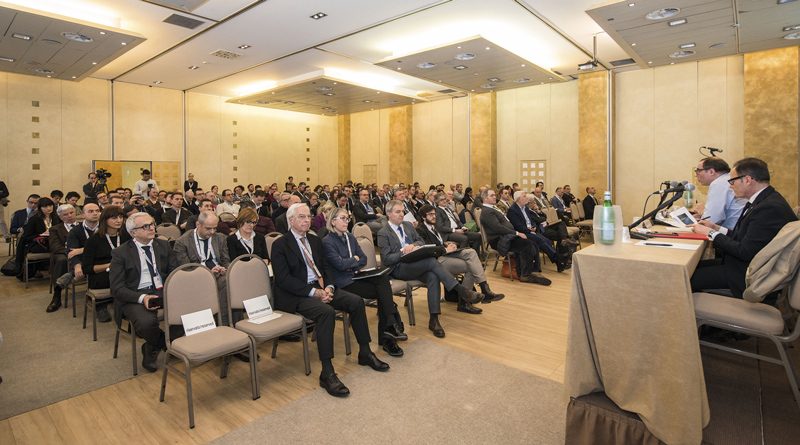Industry 4.0 Plan: One Year Later
Just over a year after the introduction of the incentives to industrial investments in 4.0-ready production machines and systems, both data and economic indicators show their positive effects on the Italian manufacturing industry. The second step, started with the approval of the 2018 Budget Law, basically confirms the incentives and introduces tax measures aimed at stimulating the demand for training. This was the topic of a conference organized by UCIMU – Sistemi per Produrre.
di Leonardo Albino
From Industry 4.0 to “Enterprise 4.0”, the name chosen to adjust the Plan to the Italian industry.
A year after the first conference, UCIMU – Sistemi per Produrre gathered, last January 30, entrepreneurs, journalists and stakeholders to discuss what’s foreseen in the 2018 Budget Law for companies that intend to adapt their production system and organization in compliance with Industry 4.0. A path started in 2017 with the National Plan launched by the Government, which has provided concrete benefits to the Italian manufacturing industry, as shown by the data related to machine tools orders in Italy. In fact, in 2017, the orders collected in Italy by machine tool manufacturers grew by 45.9% compared to the previous year, which was also very positive.
The challenge of education
“Following an excellent 2017, the year 2018 seems to be a very positive one as well. In fact, given the average production time of capital goods, these orders will have a direct impact on production and GDP in 2018”, said Massimo Carboniero, president of UCIMU. “The year has already started with so much fuel in the tank and. In addition, we have the “turbo” of the new Enterprise 4.0 Plan that – alongside the confirmation of the super- (even with the small adjustment to the coefficient from 140% to 130%) and hyper-depreciation to 250% – has got some interesting measures about training and education”. This seems to be indeed the new challenge to be met for the sector, as proven by the results of a research conducted by Unioncamere last year, according to which the gap between labour demand and supply has grown with the economic recovery. The share of companies claiming to have difficulty in finding suitable professionals for their needs has almost doubled, from 12% in 2016 to over 21% in 2017. Such an issue is particularly widespread in mechanics or IT. As Mr Caroboniero effectlvely summarized, “it’s time to force on training”.
Manufacturing is crucial
“The manufacturing industry is central in Italy”, said Stefano Firpo, high-ranked officer at MISE, who talked about the measures included in the 2018 Budget Law to support industrial digitalization. He also answered, in the final part of the conference, to the several questions coming from the participants. “We wanted to give continuity to the incentives introduced last year – he said – also trying to take a step forward on the matter of skills, which are likely to become the bottleneck of the system. This is why we aim to develop the demand for training within companies, in order to increase not only digital skills, but also the managerial ones”. The other important measure, as far as education is concerned, is the investment plan aimed at strengthening the so-called Istituti Tecnici Superiori (ITS), school courses that, according to the data released by INDIRE at the end of 2017, are featured by an employment rate of 80% immediately after the diploma. In Italy, the ITS system has been working since 2010 and trains 8,000 students a year. In Germany, where a similar school course has been working since the 60s, about 800,000 students are trained each year. It’s quite clear that the road is still long.
The new measures in force
Analyzing the measures included by the 2018 Budget Law, the super-deprectation (now 130%) and the hyper-depreciation to 250%, which can be both applied to any asset purchased by December 31st, 2018, have been confirmed, with the possibility to postpone the purchase by June 30th, 2019, if the order is accepted by the seller before the end of the previous year and if a deposit equal to at least 20% of the asset value has been paid by the same date. The so-called Sabatini Law was also refinanced (330 million euro in the years 2018-2023) and a new fund was set up, with a budget of 250 million euro a year, for innovation and industrial research in compliance with Industry 4.0. As already mentioned, some relevant innovations are related to training, with the introduction of a “4.0” tax credit of 40% on the cost of employees who carry out 4.0-related training activities. This tax credit is agreed through national or regional collective agreements and a maximum contribution per company of 300,000 euro per year is foreseen (the tax credit does not apply to the remuneration of external teachers). Finally, investments aimed at strengthening the ITS will be 65 million euro in the next three years, with the aim of increasing the number of students involved from the current 9,000 to at least 15,000.

